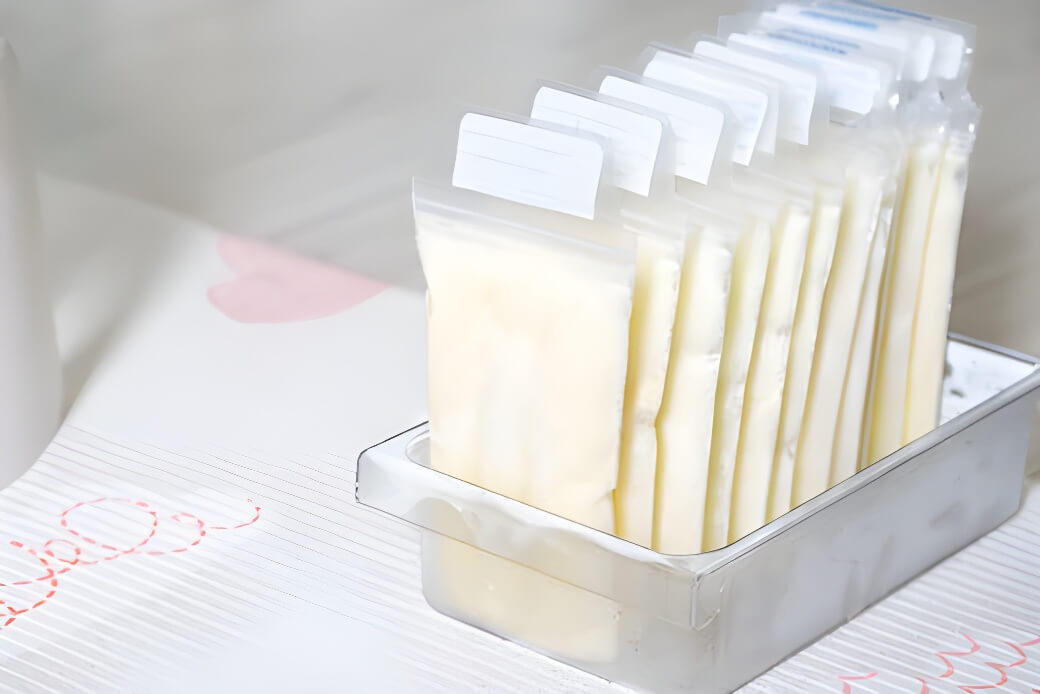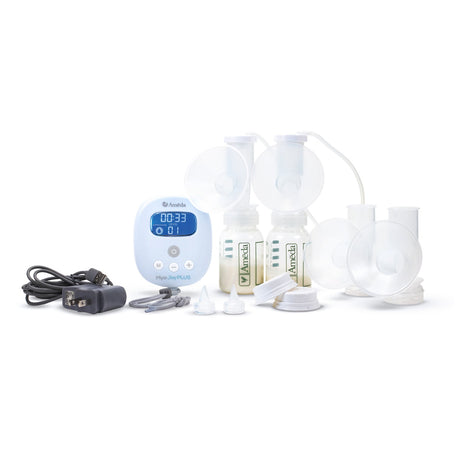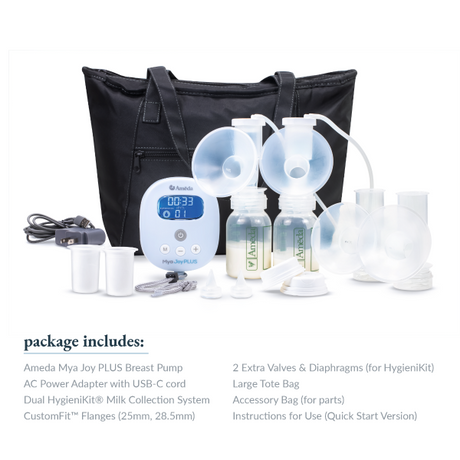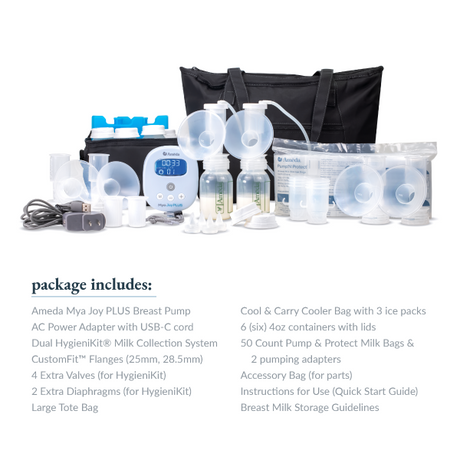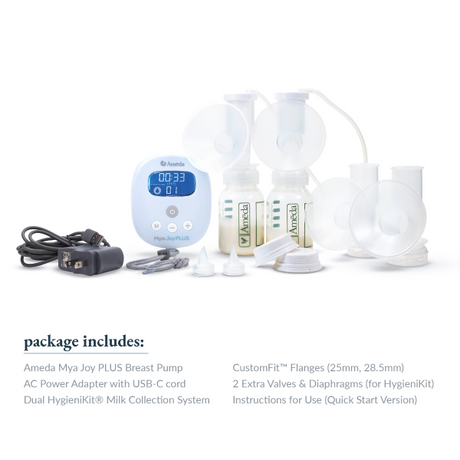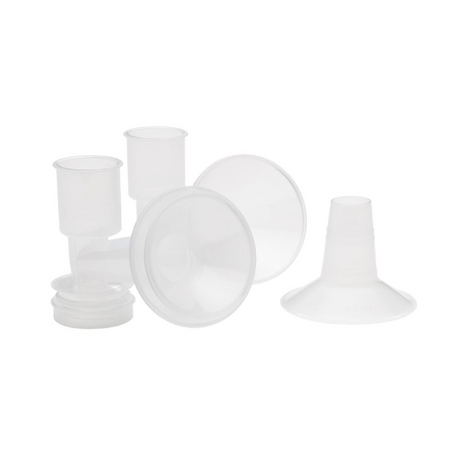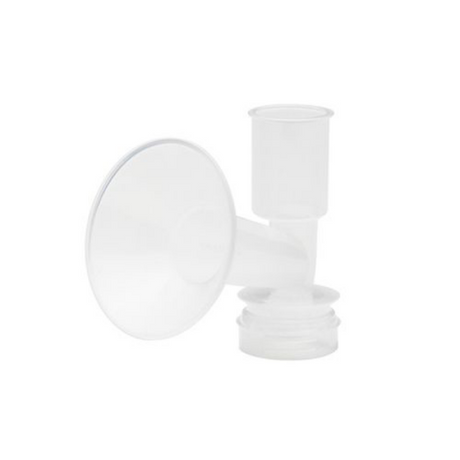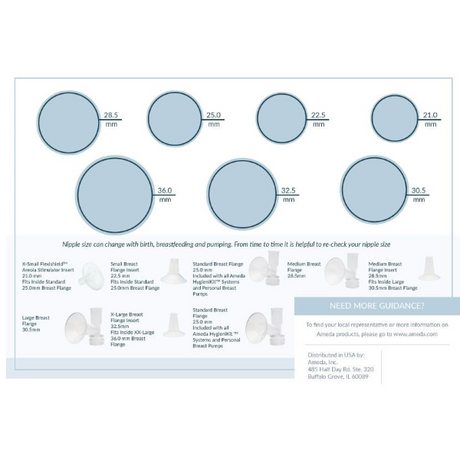Published:
Breastfeeding is a unique journey for every mother and baby, and many new moms find themselves wondering if they’re producing enough milk. This is a common concern, especially when life gets busy or when breastfeeding directly isn’t always possible. A breast pump can be an invaluable tool in helping you maintain and even boost your milk supply, providing flexibility and peace of mind. Whether you’re exclusively pumping, combining breastfeeding with pumping, or looking for ways to increase your milk supply to store milk for later, understanding how to use a pump effectively can make a big difference.
From adjusting your pump settings to power pumping and ensuring you're well-hydrated, there are many ways to help increase your milk supply. Here are some practical tips from Ameda to help you along your breastfeeding journey, ensuring you and your baby get the most out of your breastfeeding experience.
Pump Frequently and Consistently
Milk production works on a supply-and-demand basis. The more frequently you express milk, the more signals you send to your body to produce it. Aim to pump 8 to 12 times within a 24-hour period, mimicking a newborn's feeding schedule. If you’re exclusively pumping, try not to go more than 3 hours without pumping during the day and 4 to 5 hours at night. Consistent pumping sessions help keep milk production steady and prevent your breasts from becoming too full, which can decrease supply.
Make Use of Double Pumping
Double pumping (using a double electric breast pump to pump both breasts simultaneously) is more effective than single pumping for increasing milk supply. Research shows that double pumping can yield 18% more milk compared to pumping each breast separately. It also helps achieve higher levels of prolactin, the hormone responsible for milk production. Using a high-quality double breast pump can save time and maximize milk output.
Incorporate Breast Massage and Compression
Massaging your breasts before and during pumping can help stimulate milk flow and increase the volume of milk expressed. Gently massage your breasts in circular motions, moving from the outer edges toward the nipple. While pumping, use compression techniques by squeezing and pressing on the milk-producing areas to help drain the milk ducts effectively. This can encourage more milk to be released and can be especially helpful when you notice a decrease in flow during a session.
Use a Hands-Free Pumping Bra
A hands-free pumping bra can help keep the breast shields in place and allows you to perform breast compressions easily while pumping. This can be particularly helpful for double pumping, making the process more comfortable and efficient. By freeing up your hands, you can relax, massage, or even multitask, which can make the pumping experience less stressful and more productive.
Ensure Proper Flange Fit
The breast shield or flange is the part of the pump that fits over your nipple and areola. If the flange doesn’t fit correctly, it can cause discomfort and reduce milk output. A flange that is too small or too large can impede milk flow and even lead to sore nipples or blocked ducts. Ameda offers a range of CustomFit Breast Pump Flanges™ to accommodate different nipple sizes, ensuring a comfortable and effective pumping experience. Make sure you find the right size for you to improve milk expression.
Try Power Pumping
Power pumping is a technique that mimics cluster feeding—a pattern where babies feed more frequently for short periods. To power pump, try pumping for 20 minutes, resting for 10 minutes, pumping for another 10 minutes, resting for another 10 minutes, and then pumping for a final 10 minutes. This technique can be done once a day and is believed to help stimulate increased milk production by mimicking the baby’s natural demand patterns.
Stay Hydrated and Nourished
Your body needs plenty of fluids and nutrients to produce milk. Make sure to drink plenty of water throughout the day and include nutrient-rich foods in your diet, such as fruits, vegetables, whole grains, and lean proteins. Foods known as galactagogues, like oatmeal, flaxseed, and brewer’s yeast, are often believed to help boost milk supply. Staying hydrated and eating well not only supports milk production but also helps keep you energized and healthy.
Create a Relaxing Pumping Environment
Stress can interfere with milk letdown, so try to create a calming and comfortable environment for your pumping sessions. You could play soothing music, practice deep breathing, or use a warm compress on your breasts before pumping to help with relaxation. Some mothers find that visualizing milk flow or using a guided meditation app can also enhance the letdown reflex, making pumping more productive.
Include Your Baby
Your body naturally responds to your baby, so incorporating something familiar can help stimulate milk flow. If you’re pumping away from your baby, try bringing along a photo, a piece of clothing, or a blanket that carries your baby’s scent. Many mothers find that looking at pictures or holding a familiar item while pumping can trigger the letdown reflex and improve milk output. This emotional connection can remind your body of your baby’s presence, helping to increase pumping volume.
Use Pump Settings Strategically
Most electric breast pumps have adjustable settings for suction strength and speed. Start with a faster, lower suction setting to initiate letdown and mimic the rapid suckling a baby uses when first starting to feed. Once the milk starts flowing, switch to a slower, higher suction setting to mimic deeper, nutritive sucking and help drain the breast more fully. Finding the right settings can help maximize comfort and milk output.
Consider Breastfeeding Supplements and Consultation
Some mothers turn to lactation supplements like fenugreek, blessed thistle, or moringa to help increase milk supply. However, it’s essential to consult with a healthcare provider or lactation consultant before starting any new supplement. Additionally, a lactation consultant can help troubleshoot any issues with your pumping technique or routine and provide personalized advice to optimize milk production.
For A Breast Pump Manufacturer Trusted By Hospitals, Choose Ameda
Increasing milk supply with a breast pump requires patience, consistency, and a little bit of strategy. With the right techniques and tools, you can help ensure a steady and ample supply of breast milk for your baby. Remember, every breastfeeding journey is unique, so find what works best for you and your little one.
At Ameda, we understand that every mother's breastfeeding journey is unique, and we're here to help you reach your feeding goals. As pioneers in hospital-grade breast pump technology, trusted by over 100 hospitals and numerous medical facilities, we bring our expertise and care to you. Beyond our high-quality breast pumps, we provide a wealth of resources and tips to help you increase your milk supply and navigate any challenges that may arise. With products designed to be safe, effective, and comfortable, Ameda is dedicated to giving you the confidence and peace of mind you deserve. Discover our range of breast pumps and breastfeeding resources, trusted by healthcare professionals and loved by moms, to help you and your baby thrive.

